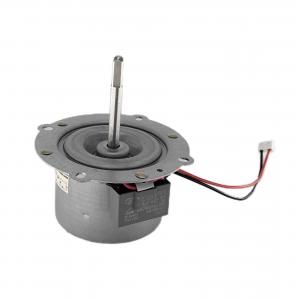
Add to Cart
Essential Details
Class of insulation: CLASS B
Warranty: 3 Years
Model Number: KG-7812M22
Rated Voltage: 220V
Rated Speed: 1100-1200RPM
Rated Power: 61-64W
Continuous Current: Customizable
Place of Origin: Guangdong, China
Type: AC Induction Motor
Application: Spin Dryer
Rated Torque: Customizable
Lead Time
| Quantity | 1-1000 | 1001-10000 | ≥10000 |
| Lead days | 15 | 30 | To be negotation |
Product Description
| Rated Speed | 1100-1200RPM | Rated Voltage | 220V |
| Rated Power | 61-64W | Rated Torque | Customizable |
Drawing

Sample

An induction motor or asynchronous motor is an AC electric motor in which the electric current in the rotor that produces torque is obtained by electromagnetic induction from the magnetic field of the stator winding.[1] An induction motor therefore needs no electrical connections to the rotor.[a] An induction motor's rotor can be either wound type or squirrel-cage type.
The stator of an induction motor consists of poles carrying supply current to induce a magnetic field that penetrates the rotor. To optimize the distribution of the magnetic field, windings are distributed in slots around the stator, with the magnetic field having the same number of north and south poles. Induction motors are most commonly run on single-phase or three-phase power, but two-phase motors exist; in theory, induction motors can have any number of phases.
Many single-phase motors having two windings can be viewed as two-phase motors, since a capacitor is used to generate a second power phase 90° from the single-phase supply and feeds it to the second motor winding. Single-phase motors require some mechanism to produce a rotating field on startup. Induction motors using a squirrel-cage rotor winding may have the rotor bars skewed slightly to smooth out torque in each revolution.
How Does An AC Motor Work?
Unlike toys and flashlights, most homes, offices, factories, and other buildings aren't powered by little batteries: they're not supplied with DC current, but with alternating current (AC), which reverses its direction about 50 times per second (with a frequency of 50 Hz). If you want to run a motor from your household AC electricity supply, instead of from a DC battery, you need a different design of motor.
In an AC motor, there's a ring of electromagnets arranged around the outside (making up the stator), which are designed to produce a rotating magnetic field. Inside the stator, there's a solid metal axle, a loop of wire, a coil, a squirrel cage made of metal bars and interconnections (like the rotating cages people sometimes get to amuse pet mice), or some other freely rotating metal part that can conduct electricity. Unlike in a DC motor, where you send power to the inner rotor, in an AC motor you send power to the outer coils that make up the stator. The coils are energized in pairs, in sequence, producing a magnetic field that rotates around the outside of the motor.
Remember that the rotor, suspended inside the magnetic field, is an electrical conductor. The magnetic field is constantly changing (because it's rotating) so, according to the laws of electromagnetism (Faraday's law, to be precise), the magnetic field produces (or induces, to use Faraday's own term) an electric current inside the rotor. If the conductor is a ring or a wire, the current flows around it in a loop.
If the conductor is simply a solid piece of metal, eddy currents swirl around it instead. Either way, the induced current produces its own magnetic field and, according to another law of electromagnetism (Lenz's law) tries to stop whatever it is that causes it—the rotating magnetic field—by rotating as well. (You can think of the rotor frantically trying to "catch up" with the rotating magnetic field in an effort to eliminate the difference in motion between them.) Electromagnetic induction is the key to why a motor like this spins—and that's why it's called an induction motor.